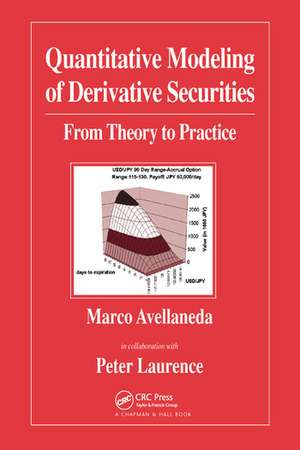Quantitative Modeling of Derivative Securities: From Theory To Practice
Autor Marco Avellaneda, Peter Laurenceen Limba Engleză Paperback – 30 iun 2020
More than just an introductory text, the reader who has mastered the contents of this one book will have breached the gap separating the novice from the technical and research literature.
Preț: 315.84 lei
Preț vechi: 358.35 lei
-12% Nou
Puncte Express: 474
Preț estimativ în valută:
60.44€ • 62.35$ • 50.43£
60.44€ • 62.35$ • 50.43£
Carte tipărită la comandă
Livrare economică 26 martie-09 aprilie
Preluare comenzi: 021 569.72.76
Specificații
ISBN-13: 9780367579142
ISBN-10: 0367579146
Pagini: 334
Dimensiuni: 174 x 246 mm
Greutate: 0.62 kg
Ediția:1
Editura: CRC Press
Colecția Chapman and Hall/CRC
ISBN-10: 0367579146
Pagini: 334
Dimensiuni: 174 x 246 mm
Greutate: 0.62 kg
Ediția:1
Editura: CRC Press
Colecția Chapman and Hall/CRC
Public țintă
Professional and Professional Practice & DevelopmentCuprins
Arbitrage Pricing Theory: The One-Period Model. Binomial Option Pricing Model. Analysis of the Black-Scholes Formula. Refinements of the Binomial Model. American-Style Options and Time-Optionality. Trinomial Trees and Finite-Difference Schemes. Brownian Motion and Ito Calculus. An Introduction to Exotic Options. Ito Processes, Continuous-Time Martingales, and Girsanov's Theorem. Continuous-Time Finance: An Introduction. Valuation of Derivative Securities. Fixed-Income Securities and the Term-Structure of Interest Rates.. The Heath-Jarrow-Morton Theorem and Multidimensional Term-Structure Model. Exponential-Affine Models. Interest-Rate Options. Appendix: The Intertemporal Discrete Model.
Notă biografică
Marco Avellaneda, Peter Laurence
Recenzii
"This fine treatment of the arbitrage pricing of derivatives will become a standard. Avellaneda and Laurence have brought their extensive combined knowledge in [a treatment] mathematics that financial analysts will find both concrete and authoritative."
-Darrell Duffie, Professor of Finance, Graduate School of Business, Stanford University
"I learned a great deal of what I know of mathematics finance from Marco Avellaneda - and I know I will learn a lot more. Not only is he a great scholar, but he is a superb pedagogue, capable to cut to the chase and avoid needless complications - with the ease and simplicity of those who truly master the subject. I am glad this book by Avellaneda and Laurence is out so more people can share his knowledge."
-Nassim Taleb, Trader, Paribas Capital Markets
"Written by two of the field's leading experts, this book stands out from the crowd of recent books on derivatives pricing theory. I recommend it to anyone interested in this fascinating field."
-Peter Carr, Principal, Bank of America Securities
"This is a textbook, though it contains no exercises, on the theory underlying the modeling and risk management of financial derivatives. The authors attempt to link theory with practice, not flinching from pointing out that the theory does no have all the answers. The mathematical style is informal, assuming an understanding of linear algebra and elementary probability, but not requiring a grasp of measure theory. It introduces stochastic calculus.
"Despite the recent publicity concerning how physics PhDs can find highly remunerative employment in this area, the authors point out that "financial modeling is very different from modeling in the natural sciences. Unlike physics, where we deal with reproducible experiments with well-defined initial conditions, the models and ideas presented in this book deal with phenomena for which we have only limited information and that are not necessarily reproducible." To me this seems to pose a challenge perfectly matched to statistical techniques. Overall, it would be worth considering as a text for a postgraduate course on arbitrage pricing theory."
-Short Book Reviews of the ISI
"…an introduction to derivative pricing…recommended to both practitioners and academics…relevant in practice…"
--Mathematical Reviews Clippings, 2000j
-Darrell Duffie, Professor of Finance, Graduate School of Business, Stanford University
"I learned a great deal of what I know of mathematics finance from Marco Avellaneda - and I know I will learn a lot more. Not only is he a great scholar, but he is a superb pedagogue, capable to cut to the chase and avoid needless complications - with the ease and simplicity of those who truly master the subject. I am glad this book by Avellaneda and Laurence is out so more people can share his knowledge."
-Nassim Taleb, Trader, Paribas Capital Markets
"Written by two of the field's leading experts, this book stands out from the crowd of recent books on derivatives pricing theory. I recommend it to anyone interested in this fascinating field."
-Peter Carr, Principal, Bank of America Securities
"This is a textbook, though it contains no exercises, on the theory underlying the modeling and risk management of financial derivatives. The authors attempt to link theory with practice, not flinching from pointing out that the theory does no have all the answers. The mathematical style is informal, assuming an understanding of linear algebra and elementary probability, but not requiring a grasp of measure theory. It introduces stochastic calculus.
"Despite the recent publicity concerning how physics PhDs can find highly remunerative employment in this area, the authors point out that "financial modeling is very different from modeling in the natural sciences. Unlike physics, where we deal with reproducible experiments with well-defined initial conditions, the models and ideas presented in this book deal with phenomena for which we have only limited information and that are not necessarily reproducible." To me this seems to pose a challenge perfectly matched to statistical techniques. Overall, it would be worth considering as a text for a postgraduate course on arbitrage pricing theory."
-Short Book Reviews of the ISI
"…an introduction to derivative pricing…recommended to both practitioners and academics…relevant in practice…"
--Mathematical Reviews Clippings, 2000j
Descriere
Based primarily on the analysis of derivatives, Quantitative Modeling of Derivative Securities emphasizes relative-value and hedging ideas applied to different financial instruments. It demonstrates how to take the basic ideas of arbitrage theory and apply them to the design and analysis of financial products. Using a financial engineering approach
